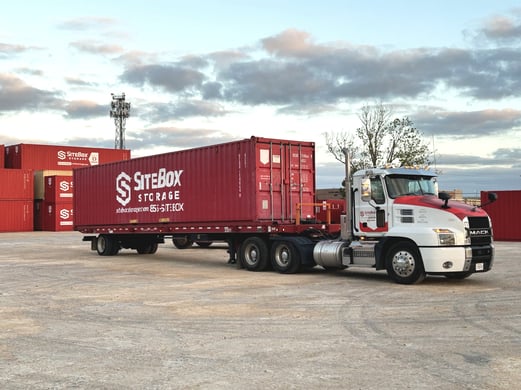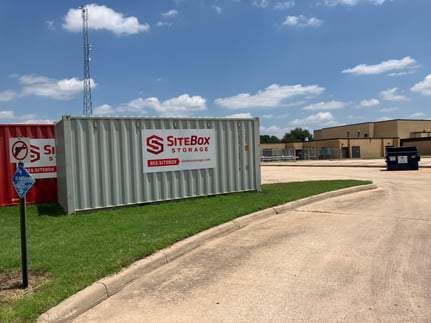Choosing a Storage Container: Your Essential Guide to Sizes and Types

Look, picking a storage container shouldn't give you a headache. But when you're staring at a dozen different sizes and wondering which one actually fits your stuff, it's easy to feel lost. Maybe you're a contractor tired of tools getting stolen from job sites. Or a business owner who just ran out of space for inventory. Or maybe you're mid-renovation with your entire living room furniture sitting in the garage.
Here's the thing: once you understand container dimensions and what type works for different situations, the decision gets pretty straightforward. Let's break down everything you actually need to know.
Standard Storage Container Sizes
Storage containers measure 8 feet wide across the board—that's standard thanks to shipping industry requirements. Where things differ is length and height.
You'll typically see 10-foot, 20-foot, and 40-foot lengths. These aren't random measurements. They come from cargo shipping standards, which means these boxes were originally built to survive ocean crossings. That same toughness works great when you just need to store your belongings on solid ground.
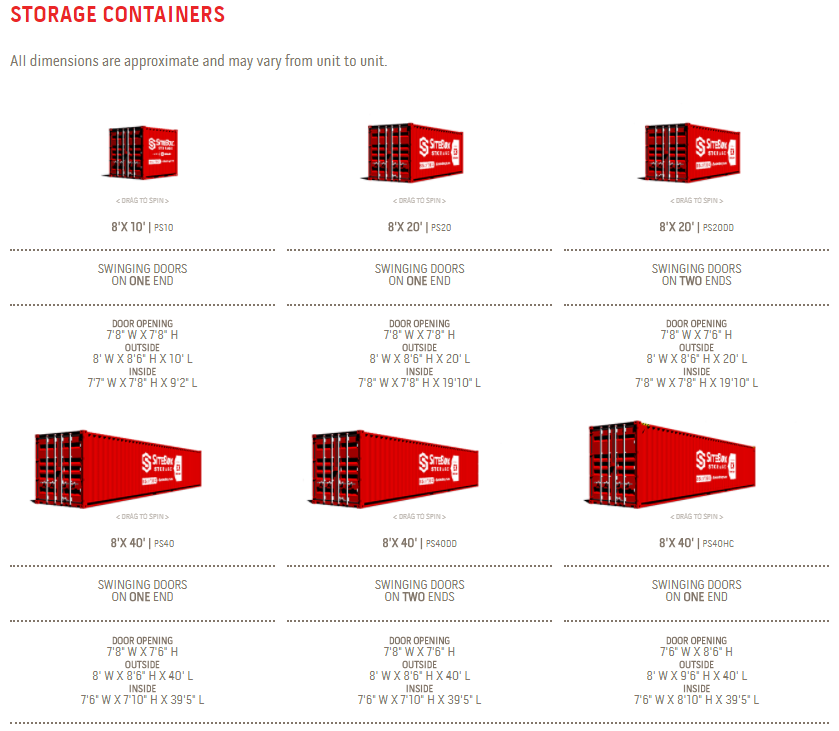
A 20-foot container gives you about 160 square feet of floor space. Sounds modest until you start stacking efficiently—you'd be shocked how much actually fits. Interior height usually runs 7 feet 10 inches, enough room that most people won't bang their head walking around inside.
High cube containers add extra ceiling height up to 9 feet 6 inches. Storing furniture? Long pipes? Equipment that stands tall? That extra space up top becomes worth its weight in gold. Construction crews especially love high cubes when they're storing ladders and lumber vertically.
Types of Storage Containers
Not every container does the same job. About 72% of containers in use are standard dry cargo units—steel construction, swing-out doors at the ends. They handle weather pretty well and work for most general storage: boxes, equipment, seasonal stuff, documents, typical household belongings.
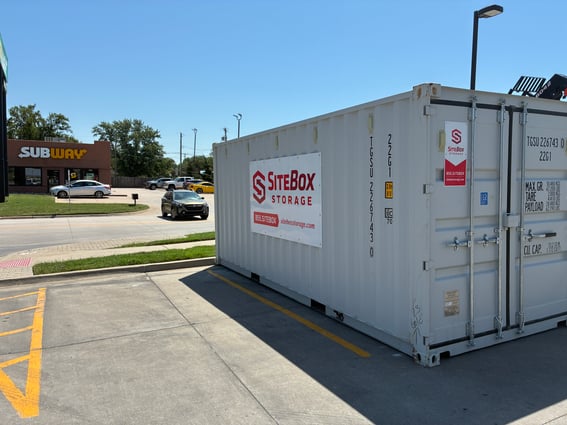
Refrigerated containers (reefers) are a whole different animal. Around 38% of businesses handling perishable goods swear by refrigerated containers instead of traditional cold storage facilities. These maintain specific temperatures, protecting food shipments and temperature-sensitive products. The reefer market keeps growing because people are realizing how useful mobile temperature control actually is.
Then there are open-top and flat-rack containers for oversized cargo that won't squeeze through regular doors. Construction companies use these for steel beams, heavy machinery, industrial equipment. The open design lets cranes load from above, which speeds everything up.
Shipping Containers for Storage
Most people don't realize this: those portable storage containers? They started life crossing oceans as shipping containers. We're not talking flimsy units from storage facilities. These are heavy-gauge steel boxes built to handle salt water, stacking weight, and constant transport across rough seas.
After completing ocean voyages—often just one trip from factories overseas to the United States—companies inspect them, make necessary modifications, and put them back to work on construction sites, business locations, and residential properties nationwide.

Shipping container dimensions designed for cargo transport work brilliantly for ground storage. Standard sizes fit on trucks for delivery. Their stackable design lets you place multiple units without hogging tons of space. And those lockable cargo doors? Way more secure than your average storage shed.
Portable Storage Units vs Traditional Facilities
Here's where portable units shine: the container comes to you instead of making endless trips across town to some storage facility. Park it in your driveway, on your job site, in your parking lot, wherever you've got space.
During moves, this convenience changes everything. Load the container slowly over several days instead of rushing. Then have it delivered straight to your destination. No rental truck. No driving back and forth. Pack once, you're done.
For businesses, portable units solve constant headaches around equipment storage between projects. Construction companies park containers right on job sites—tools and materials stay secure overnight. Retail shops use them during seasonal inventory spikes. Event companies rely on them for festival equipment between venues.
The mobility gives you flexibility traditional storage can't touch. Relocating? The container moves with you. Project wrapping up? Schedule pickup and it's gone. Plans always change, and portable units change with them.
Specialty Containers and Indoor vs Outdoor Options
Beyond standard containers, specialty options exist for unique challenges. Tank containers transport liquids safely. Insulated containers protect from temperature swings without active refrigeration. Modified containers can include shelving, interior walls, windows, electrical wiring—some companies transform them completely into temporary offices or workshops.
Indoor storage facilities have their place. Climate control works great for sensitive items. But you're paying monthly whether you use it all month or not. You're driving there constantly. During peak season, finding space gets tough.
Outdoor container storage puts the unit on your property. No driving. No restricted access hours. Your stuff stays within sight. Steel construction handles weather while quality locks discourage theft. For businesses, having storage on-site means workers grab what they need in seconds instead of someone driving across town.
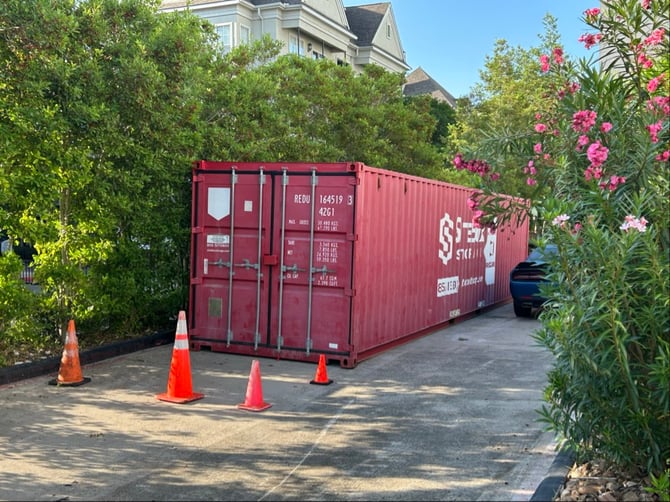
Most people find outdoor containers offer better convenience and pricing for temporary or project-based storage.
Choosing the Right Container Size
List everything you're planning to store. Walk through your garage, closets, storage areas—wherever stuff piles up. Be honest about volume. Most people underestimate how much they have, then panic when the container shows up too small.
Measure where you want the container placed. A 40-footer needs 40 feet of clear space plus room for the delivery truck to maneuver. Limited space? Two 20-foot containers might beat one giant 40-footer.
Think about access patterns. Will you dig into the container frequently? Put items you'll need often near the door. If everything goes in once and stays sealed until move-out, organization matters less.
Quick guide:
- 10-foot: studio apartments, small moves, seasonal gear, construction tools for smaller crews
- 20-foot: 2-3 bedroom homes, business inventory, renovation projects, mid-sized job sites
- 40-foot: entire household moves, large business storage, major construction operations
When uncertain, go bigger. Nobody complains about too much storage space. Running out halfway through packing? Major headache.
Key Features Worth Checking
Steel construction isn't optional for security and durability. Quality containers use corrosion-resistant steel lasting decades. Check for rust spots, dents, or structural damage that might let weather in.
Door configuration matters more than you'd think. Standard containers have double doors at one end. Units with doors on both ends? Much easier accessing stored items—load from either direction, reach stuff in the middle without unloading everything.

Weatherproof seals around doors keep moisture out. Containers built for ocean shipping already have solid weatherproofing, but older units might need new seals. Water damage ruins belongings fast.
Locking mechanisms vary wildly. Basic containers come with simple lockable handles. Serious security means lockboxes preventing bolt cutters from accessing locks. Some customers add alarm systems or security cameras for high-value equipment.
Check interior condition. Wood floors should be solid without soft spots. Metal walls and roof should look clean and dry. Concerning odors? Previous cargo might affect your stored items.
What You'll Actually Pay
Rental costs run $100 to $500 monthly depending on size and location. A 10-footer costs less than a 40-footer. Rental makes sense short-term—moves, renovations, seasonal business storage.
Purchase prices start around $1,000 for used containers in fair shape. Quality 20-foot containers run $3,000 to $5,000. Pristine 40-footers with customizations might hit $20,000. Long-term storage needs? Purchasing beats years of rental fees.
One-trip containers (used once for overseas shipping) cost more than containers with years of service. But you get maximum remaining lifespan with minimal wear concerns.
Do the math on total ownership cost. Renting three months might cost $450. Need storage longer? Purchasing looks more attractive. Factor delivery fees either way—most companies charge for drop-off and pickup.
Packing Smart
Use plastic bins instead of cardboard when possible. Clear containers show contents without opening anything. Plastic stacks better than cardboard, which crushes under weight. Better protection against moisture too.
Label everything clearly on multiple sides. You'll thank yourself hunting for something later. Write contents large enough to read from several feet away.
Create aisles if you'll access the container during storage. Yes, this "wastes" floor space. But consider the alternative—unloading half the container reaching something in back. Leave at least a narrow walkway down the center.
Load heavy items first toward front and bottom. Creates stable base, prevents crushing lighter items. Furniture often works best upright to maximize vertical space.
Disassemble furniture when possible. Table legs come off. Bed frames break down. Fifteen minutes disassembling saves enormous space and protects furniture during transport.
Fill empty spaces in furniture. Dresser drawers can hold clothes, linens, small items. Don't move empty furniture—use every cubic foot.
Use shelving for long-term rentals. Many companies offer shelving accessories mounting to walls. Drastically improves organization and space utilization.
Frequently Asked Questions
What are common storage container sizes?
Most common sizes are 10-foot, 20-foot, and 40-foot lengths, all measuring 8 feet wide. Standard height runs 8 to 8.5 feet, while high cubes offer 9.5 to 10 feet interior height. Floor space ranges from 80 square feet (10-foot) up to 320 square feet (40-foot).
What types of storage containers are available?
Over 15 distinct types exist. Standard dry cargo handles most general storage. Refrigerated reefers maintain temperature control for perishables. Tank containers transport liquids safely. Open-top and flat-rack accommodate oversized cargo. Modified containers include office conversions and custom workspace setups.
How do I choose the right size container?
Inventory everything you're storing. Measure larger items and furniture. Consider available space—40-footers need significant room for placement and delivery. Think about access needs during storage. When doubtful, size up. Ten-foot containers work for small apartments, 20-foot handles typical home moves, 40-foot accommodates entire households or large business needs.
Are there storage containers for outdoor use?
Absolutely. Most were designed for outdoor use originally. Shipping containers built for ocean transport handle harsh weather easily. Steel construction, weatherproof seals, elevated floors keep contents protected from rain, snow, ground moisture. Place on level ground for best results. Many keep containers outdoors for years without issues.
What materials are storage containers made of?
Primarily corrosion-resistant steel—same material used in ocean cargo shipping. Steel provides durability, security, weather protection. Some smaller bins and totes come in plastic or metal. Heavy-duty commercial containers stick with steel construction. The metal frame gives containers their strength and multi-decade lifespan.
Which storage containers are best for food?
Refrigerated reefer containers provide the best solution, maintaining precise temperature controls keeping food fresh and safe. About 38% of businesses prefer refrigerated containers for perishable goods. For non-perishables, standard airtight containers work fine. Make sure any food storage container is clean and never transported hazardous materials.
How much weight can storage containers hold?
Depends on size and construction. Standard 20-footers typically handle approximately 48,500 pounds of cargo. Forty-footers hold around 58,400 pounds. The average container volume used is approximately 33.1 cubic meters. Most household belongings rarely approach maximum weight limits. Furniture, boxes, clothing, typical items stay well under capacity. Industrial equipment and heavy machinery require more attention to weight distribution.
Are stackable storage containers available?
Yes, stackable designs are common. Shipping containers were engineered to stack on ships and in shipping yards, handling stacking extremely well. Corner posts lock together for stable stacking. Some businesses stack two or three containers maximizing vertical space while minimizing property footprint. Over 54% of shipping companies use high-cube containers specifically because they offer increased capacity when stacked.
What are the benefits of plastic vs metal containers?
For small storage, plastic bins offer lightweight portability, transparency seeing contents, lower cost. Plastic containers come stackable, airtight, even collapsible—perfect for organizing closets, garages, small spaces. Metal containers (steel shipping containers) provide vastly superior security, weather protection, durability for large-scale storage. Metal construction prevents break-ins, protects against elements for years or decades. Choose plastic organizing your house and moving small items. Choose metal for serious storage needs.
How do I clean and maintain storage containers?
Maintenance stays minimal with steel containers. Inspect regularly for rust spots, treat promptly with rust converter and paint. Check door seals, replace if cracking or letting moisture through. Sweep interior periodically preventing dirt buildup. For plastic bins, warm soapy water handles most cleaning. Ensure containers fully dry before storing items preventing mold or mildew. Well-maintained steel containers last 25 years or more with basic upkeep.
Choosing the right storage container doesn't need overthinking. Start with honest assessment of what you're storing and available space. Match that to standard container sizes and you're most of the way there. Steel containers protect your belongings better than traditional storage alternatives, while having storage right on your property saves time and hassle.
Whether managing construction sites, expanding business inventory, or coordinating family moves, storage containers provide flexible solutions adapting to changing needs. Armed with this guide, you can confidently select containers working for your situation and budget.
Get a quote for your storage needs!

